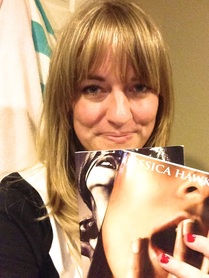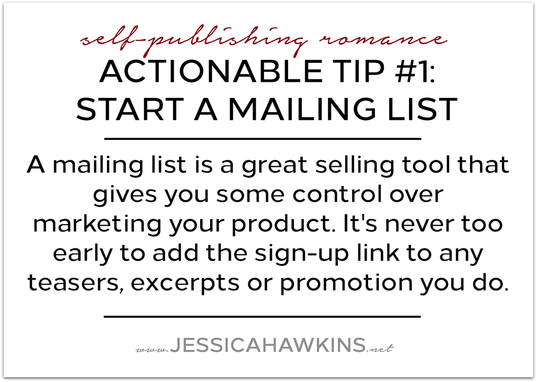Once in a while, I'll get a question about how I self-publish my books. It's tough, because there are so many aspects to this process, from craft to business and everything in between. Which is basically the idea behind being self-published—I have creative and decision-making freedom, but I also don't have anyone, well... making decisions for me. So when I got a tweet from Kamrun N. asking for advice on self-publishing, I knew I couldn't possibly give her anything valuable in a simple tweet. After some thought and a long e-mail, I decided there were probably others who could use this information. Luckily, Kamrun agreed to let me post our exchange. So, whether you've already written your first book, are in the throes of your literary debut or if you're just toying with the idea of self-publishing, here's a few things to consider and some tips you can take action on right now. (In a hurry? I've bullet-pointed 5 action steps at the bottom.)
Kamrun (and, now, all interested parties)--
Congrats on taking this leap! I know deciding between self- and traditional-publishing can be difficult, but I've been writing and publishing my own romance for about 2.5 years, and I've never looked back. I learn something new every day. Since I don't know where you're at in the process or what you're hoping to accomplish, I'll mostly cover the business side of self-publishing. I'm assuming, with the advice I'm about to give, that you want to a) find people to actually read your work and b) earn income from your writing.
I think the first and most important thing to recognize about self publishing for income, no matter where you are in the process, is that it's a business. I like to joke that writing the actual manuscript is the easy part. I can only speak from my experience and the observation of those around me, but aside from a few outliers, building an audience won't happen overnight; it takes time and work. Basically, you have no one to rely on but yourself—because you are the publisher. Fortunately, there are many books, podcasts, communities and websites out there to help, and I’ll link to some that've helped me at the end of this post.
So where do you even begin if you want people to see your work? Social media is a great place to dip your toes into the marketing/promotion pool because it's free (unless you put a price on 'writing time,' which is something you should do once you're up & running). So, okay, if you're like,
Here are some actions you can take right now that'll cost you nothing but a few minutes: sign up for a Twitter account and a Facebook Page (this is different than your everyday Facebook account). Then, start a mailing list. Add the sign-up link to any teasers, excerpts or promotion you do. On release day, send out a blast. When a platform like Amazon sees early interest in your book, it likes that. It wants to help you help them by putting it in front of even more people. Only managed to snag 10 emails by the big day? That’s 10 more potential sales than you have right now. A mailing list is a great selling tool that gives you some control over marketing your product.
 Showing off my PBs after my first book signing.
Showing off my PBs after my first book signing. Kindle Direct Publishing (KDP), which is Amazon's digital self-pub platform. Other platforms to look at for digital publishing (unless you're enrolling in Kindle Unlimited, which is a whole other topic), are Barnes & Noble (nookpress.com), Kobo (Kobo Writing Life), iBooks, and Google Play. Authors also have the option of going through a distributor like Draft2Digital, Smashwords or Book Country to knock out most of these all at once. For a percent of your profits (typically 10-15%), you can upload one document to their system and they'll format it for most of those platforms and more (costs and available platforms vary by distributor, which I'll cover in another post).
For paperbacks, I use Createspace, an Amazon subsidiary, which is fairly straightforward and provides info on formatting and cover design. Through CS, you sell your paperbacks via Amazon "on demand" so neither you nor Amazon is holding any inventory—the book is only printed when it's ordered by a customer and then it's shipped directly to them. There's no upfront cost (aside from what goes into making a paperback). They take a percentage plus the cost of printing. Easy! (Note: there are options to distribute your on-demand paperbacks to other online retailers as well, such as Barnes and Noble.) Do I sell many paperbacks? No. I'm not in any brick & mortar stores. They are less than 1% of my overall sales. I still recommend taking the time to do it. They make great, physical promotional tools, especially at book signings, and sales is sales, know what I mean? (There's also no feeling like holding your own book in your hand.)
You might be asking—what’s the bottom line? What's self-publishing going to cost me? In my experience—leaving marketing & advertising out of it for now—you can decide what you're willing to learn and what you prefer to outsource. Self-publishing can be less expensive (or cost nearly nothing at all) if you're open to DIY. I taught myself formatting, and I did the covers of my first series, howwwweever I don't really recommend doing either without taking the time to learn to do it well. (Like most things the last couple years, my covers have been through a couple iterations, and the evidence is out there forever.) If I were getting into craft, right about now I'd be brainwashing you about the benefits of hiring an editor, but I'm saving that for another post. This is definitely something you want to add into the budget, though.
What's awesome is that there are a wealth of freelance options available and more cropping up all the time—just make sure to stay smart and do your research. Cover photos typically come from stock photo sites like DepositPhotos (free trial, upper left hand corner), but since self-publishing is a flourishing industry, you do run the risk of stumbling upon your beautiful, unique, took-me-forever-to-find stock photo on another book (or more likely, it's already on one). You also run another risk, the one where you search "sexy couples" and are assaulted by some pretty gnarly visuals that are ANYTHING but sexy. But that's a price you pay for creative freedom... ¯\_(ツ)_/¯
Many authors these days choose to hire a photographer for custom photo shoots or purchase an exclusive license for an existing stock photo—both of which can be expensive.
Have questions about what you've read? Feel free to tweet me @jess_hawk. This was an introductory post for both you & me, but I do intend to write more on a slew of different topics. (And who knows? It could turn into much more. Like, I don't know—a book?) Sign up for my self-publishing mailing list to get notified about new posts. (See what I did there? Putting actionable tip #1 to good use.) Below, I’ve added some of my favorite resources from over the years for those who’d like to dive deeper into what I’ve covered here. Some of them are affiliate links, but I don't recommend anything/one I haven't tried or know other authors are happy using.
Resources
Podcasts:
Rocking Self Publishing (beginner-intermediate)
The Creative Penn (intermediate-advanced)
Author Strong
Kobo Writing Life
Books:
APE: Author, Publisher, Entrepreneur
Self-Editing for Fiction Writers
Community:
You can read questions & answers for days here: KDP Community Boards and Kboards.com Writer's Cafe
Websites Worth Exploring:
BookBub Blog
The Creative Penn
Editing/Covers/Promotion:
Recommendations from other authors are a good place to start with this, since my own experience is limited to the books I’ve published. I don't feel completely comfortable recommending editors blindly, but I've listed a few well-known ones below. Comment on this post with what you're looking for—you never know!
For proofreading/copyediting, I use Elance.com which is now UpWork.com
Editors - AdeptEdits, WriteDivas, Unforeseen Editing
Mailing list - Mailchimp (my preferred choice, but there are others)
Website - I'm tech-dense, so I use drag-and-drop website builder Weebly
Stock photos – DepositPhotos, BigStockPhoto, iStockPhoto
Cover design – CoverIt! Designs (Ari), LM Creations (Louisa), Joshua Jadon
Promotion – The Book Enthusiast (Debra), Love Between the Sheets, IndieSage PR (Nicole)
As promised, if you’re feeling overwhelmed or want to make like milk and skim, here are 5 business-oriented steps you can start now:
1. Sign up for a KDP account, get to know the platform and check out the KDP Community Boards/Kboards I mentioned above. Research Kindle Unlimited before you move on to other platforms.
2. Ask other authors for recommendations on editing, formatting and cover design so you can begin the process outside of writing.
3. During writing downtime, get social media accounts set up. Begin with the platform you're most comfortable with (generally a Facebook Page) and a website. Start paying attention to things like fonts, colors, themes, etc., which will help your cover designer and will also give you some ideas about your brand.
4. Decide if you want to do any kind of pre-release and/or release day promotion (recommended). If you have even a small social following when you hit publish, that helps.
5. Browse through stock photo sites to get ideas for a cover (fun at first, and then really tedious). Who knows? You might get some inspiration for your next book, and you can't put a price on that.
DISCLAIMER! Although I’ve added my personal recommendations to this blog post, I urge you to do your own research and exploration before committing to anything. This post is meant to be a helpful guide for getting started, but what works for me may not work for you.





 RSS Feed
RSS Feed